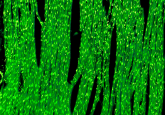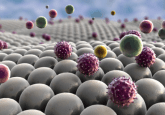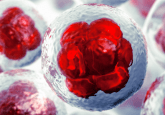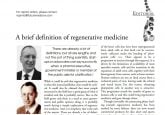Developing citrate-based biomaterials: an interview with Guillermo Ameer

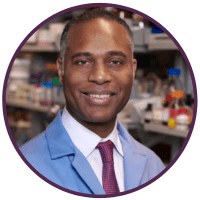 Guillermo Ameer is the Daniel Hale Williams Professor in the Department of Biomedical Engineering and the Department of Surgery at Northwestern University (IL, USA). He is also the founding Director of the Center for Advanced Regenerative Engineering. The center is dedicated to promoting regenerative engineering, an exciting field that is the convergence of advances in material sciences, stem cell and developmental biology, physical sciences, and translational medicine to develop tools, enabling surgeons to improve the outcomes of tissue and organ reconstruction surgeries.
Guillermo Ameer is the Daniel Hale Williams Professor in the Department of Biomedical Engineering and the Department of Surgery at Northwestern University (IL, USA). He is also the founding Director of the Center for Advanced Regenerative Engineering. The center is dedicated to promoting regenerative engineering, an exciting field that is the convergence of advances in material sciences, stem cell and developmental biology, physical sciences, and translational medicine to develop tools, enabling surgeons to improve the outcomes of tissue and organ reconstruction surgeries.
A native of Panama, Guillermo has over 20 years of experience in the field and his lab’s research focuses on developing biomaterials, drug delivery systems and other strategies that will enable the regeneration of tissues.
In addition to research, he is actively involved in education and industry collaboration, recognizing the importance of engaging companies in the dynamic advancements within healthcare. He encourages faculty from diverse disciplines to contribute to this interdisciplinary research field, recognizing its potential to transform healthcare.
Here, Guillermo shares insights into the development and applications of citrate-based biomaterials in regenerative medicine and explores the considerations for clinical translation.
One of your primary focuses in research is the development of citrate-based biomaterials. Could you elaborate on its applications in regenerative medicine?
We originally developed and published the first manuscript on the synthesis, characterization and medical application of citrate-based materials in 2004 because at the time there were no readily available materials that were elastic, biodegradable, and suitable for tissue engineering applications. In regenerative engineering, one of the strategies to promote tissue regeneration is to design temporary scaffolds that are either seeded with cells from your own body or another source. But a lot of our tissues happen to be elastic, for example, skin, lung, heart. At the time, to study the impact of mechanics, for example, repeatedly straining a particular scaffold that is seeded with cells, how would that impact those cells and their development of new tissue on that scaffold?
So, we set out on a quest to develop materials that would have elastic properties and that would be degradable to enable us to study these types of processes. This led us to explore citric acid-based polymers.
Citric acid, as a molecule, is very safe. We have been using it in many forms for centuries. It is also produced by our body. So, it is not a foreign molecule to our body. As well as this, citric acid is a commodity chemical, meaning that it is very easy to produce and inexpensive, which is very important for large-scale production. And it just enables you to do really cool chemistry, very simple chemistry.
We made crosslinked polyester networks, and the little networks or entanglements within this material enabled it to stretch and recoil the way rubber would. We also discovered that these materials have inherent antioxidant properties, which would potentially help reduce or diminish the inflammatory responses that you would expect after implanting your body. So, these are the beneficial properties that we discovered when we invented these materials.
And they are also degradable. These were the first materials of their kind that were elastic and biodegradable and made using a very simple synthesis process, and also the first of their kind to be inherently antioxidant.
What are some of the important factors to consider when translating citrate-based materials into clinics?
Fortunately, our biomaterial technology has been adopted by the industry and is now available in the form of products and medical implants in the orthopedic space.
For that to happen, you need to meet the very stringent requirements of the relevant regulatory agency. For example, you have to meet safety requirements, which involve ensuring you do not have toxic substances that leach out of the device into the surrounding cells or tissues. You want to make sure that as the device degrades it does not create harmful byproducts. Comprehensive testing is necessary to demonstrate functionality and efficacy, supported by ample data and evidence.
The approved products are designed for reconstructive musculoskeletal surgeries, specifically in the ankle and the knee in sports medicine. We hope to expand the use to other sports medicine applications like repairing shoulder tendon injuries or addressing the most common knee injuries, anterior cruciate ligament damage. Eventually, there’s potential for applications in spine surgery, such as fusing the vertebrae to alleviate pain. So, we have lots of potential new uses for these types of materials.
What impact will the FDA approval of biomaterials in musculoskeletal surgeries have on the surgical landscape?
I think it is going to change how people perceive the role of biomaterials in medical device design and manufacturing. Currently, we focus a lot on non-degradable materials like metals and plastics. These materials have their use and their role, but the future for many of these applications is going to be devices that enable your body to do the healing and regenerate tissues.
As well as orthopedic and sports medicine applications, we have also done work in bladder tissue regeneration, blood vessels and islet transplantation. Islets are the pancreatic tissues responsible for secreting insulin in response to increased blood sugar. These types of materials can have an impact on a wide range of medical areas.
Looking ahead, what will be the focus of your work going forward?
We are currently collaborating with colleagues in the field of bioelectronics to develop what we call Smart Regenerative Systems (SRSs). These SRSs are implantable medical devices or systems designed to probe their microenvironment, gather data and transmit that information to the user, whether that is a caregiver, patient, doctor or manufacturer.
With that information, these systems can be programmed to respond, helping to achieve the goal of restoring the function of that particular tissue. So, these SRSs, I believe, are going to revolutionize how we think about implantable medical devices.
Our team at the Center for Advanced Regenerative Engineering has made progress in the area of bladder tissue regeneration, where we can accomplish these types of measurements. Additionally, we are working toward enabling bladder actuation so individuals with regenerative bladder tissue can urinate even if the nervous system is not fully restored. This could eliminate the need for catheters and address incontinence.
The future is going to be this integration of data science, biomaterials and bioelectronics. By combining these disciplines we can better understand what happens to these devices when they are in the body and how can we maximize your function and their impact.
What were been the most memorable and exciting moments of your career to date?
One of the most exciting things is when you graduate your first students and you see them succeed and do really well. Many of my former students are now very, very highly respected faculty at different universities worldwide, including in Europe, China and the US. Seeing their accomplishments and watching them continue their careers is one of the most rewarding parts of being a faculty member.
Also, when you see the product of your work and the impact of a team effort. Developing technologies and materials that are integrated into products that are in the knees of thousands of patients. That is hard to match. It was also very exciting when they used our first interference devices in New York. Additionally, receiving regulatory approval for the devices made with our biomaterial technology was a significant milestone. These moments, along with others, collectively contribute to the most memorable aspects of our journey.
How can diversity and inclusivity be championed in regenerative medicine?
That is a very good question. I am actively working to address it. We have programs here at Northwestern during the summertime where we welcome students from high school and community college or two-year college system. I myself went to two-year college when I was younger, trying to get my education.
We want to motivate and make sure we include everybody and reach out to those students. We have had success with high school students continuing to engineering school pursuing regenerative medicine applications. And we have had success with our community college students who have gone on to transfer to four-year colleges and pursue graduate school. It is extremely important to ensure that everybody that is willing and able to participate in this field has the opportunities available to do so.
I am very active with this. Diversity and inclusivity are paramount in our approach. What we care about is excellence. If you want to be excellent in what you do and you want to develop things that will have an impact on society, we welcome you here.
I think inclusivity is important to create a culture of and work ethic for success. Diversity is also important because the differences that we all bring to the table can lead to the best solutions to complex problems. We think differently, we approach things differently, and that is definitely an asset to solve grand challenges. We welcome and we proactively look for the best of the best, regardless of where you are from in the world. We have been very lucky to have a team that has been very productive that has developed technologies that are actually used to help people.
The opinions expressed in this interview are those of the author and do not necessarily reflect the views of RegMednet or Taylor & Francis Group.
